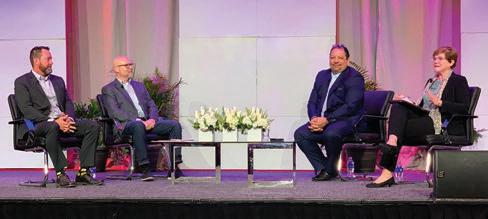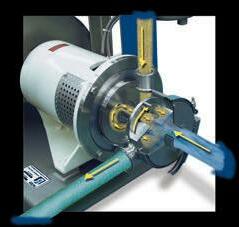
12 minute read
In the News
Sustainability, Supply Chain, Export Markets Key Topics Among Dairy Producers
AARON HAND | EDITOR-IN-CHIEF
WHEN THE U.S. DAIRY
Export Council was formed almost 27 years ago, the U.S. was exporting only about 2% of its production. Today, it’s closer to 18%. If not for some of the headwinds being created by shipping issues, it would’ve been more like 20% last year, according to Krysta Harden, president and CEO of the council.
“People love our products, they want our products, they want to be able to a ord our products,” Harden told an audience at the recent Cheese Expo in Milwaukee. “It’s up to us whether we’re going to step up and meet that demand.”
Joining Harden on stage for the keynote discussion were a handful of cheese and milk execs—all of whom lamented the supply chain woes that have befallen this industry along with just about every other industry since the start of the COVID-19 pandemic. David Ahlem, president and CEO of Hilmar Cheese, says that supply chain issues were a leading challenge for his company. “We’ve been selling a lot of stu , but we can’t get it to customers right now,” he says.
There’s underlying optimism that goes along with that. “Customers want to purchase our products even at current price levels. I’m excited about the longterm demand in the marketplace,” Ahlem says. But there’s also concern that the situation cannot continue if Hilmar wants to continue to get business. “Long term, it a ects our ability to be a reliable supplier. Customers need to know whether we can be that predictable supplier. And we need to be.”
From Harden’s perspective, it’s a concern worth losing sleep over. “I’m a good sleeper,” she says. “But the thing that wakes me up is this shipping situation.”
It used to be that U.S. dairy producers would export only what they happened to have leftover. “The industry worked so hard to change that narrative,” she says. “Is there concern that this is going to fl ip back some of that narrative?”
No, says David Lenzmeier, CEO of Milk Specialties Global. Looking at the outlook in key competing geographies, such as Europe and New Zealand, the capabilities come from North America, he says. “This is the place to be. We have the most competitive milk producers in the world in terms of size, scale, and e ciency.”
The spread of sustainability
The U.S. is in a pretty good position when it comes to the sustain-
FDA Issues Draft Action Levels for Lead in Juice
The FDA is moving to limit lead in ready-to-drink apple juice and other single-strength juices and juice blends, supporting its Closer to Zero action plan.
Kind’s Bee-Friendly Almond Sourcing Commitment Progress
Since setting its bee-friendly commitment in 2020, Kind has encouraged the expanded usage of bee-friendly practices across the almond industry. Beefriendly farmland in California has grown to more than 125,000 acres.
McCormick Names Brendan Foley as President and COO
Brendan Foley has been appointed as McCormick’s chief operating o cer and president, e ective June 1, when he will assume responsibility for all of McCormick’s business units and its supply chain worldwide.
Mondelēz Plans to Sell Chewing Gum Business
Su ering a severe decline in gum brand sales during COVID-19 lockdowns, Mondelēz International announced it’s selling this business segment, including Dentyne, Stride, Trident, and other brands, in developed markets.
Anheuser-Busch to Invest $50 Million in St. Louis Brewery
The company is adding a dedicated building that will house new systems and equipment, and upgrading a can line with advanced technical equipment, to expand the site’s seltzer and packaging capabilities and streamline the addition of fl avors to the seltzer liquid.
Krysta Harden (right) of the U.S. Dairy Export Council led a panel discussion at the Cheese Expo in Milwaukee.
ability perspective, a narrative that is increasingly spreading from Europe. “We’re globally positioned pretty well, from a productivity and e ciency standpoint,” Ahlem says. “Our greenhouse gas emissions intensity is the lowest in the world. We beat every other dairy region. And we’ve only just begun that process. We can do more and reduce that going forward.” The U.S. dairy industry owns the science; now it needs to own the narrative, he adds.
The industry needs to use the data it has to tell a better sustainability story, insists Marshall Reece, senior vice president of sales and marketing for Associated Milk Producers. “Dairy farmers have always been sustainable,” he says. “It’s hard to measure or reduce what you aren’t tracking. But we’re doing a much better job of tracking what we’re doing. With data, we can tell a great story.”
Milk Specialties began tracking more of its e orts about five years ago, Lenzmeier notes, beginning to understand better how to send fewer trucks down the road and how to better reutilize water in the plants. “The great thing is there’s always an ROI there—and it’s the right thing to do,” he says. “Everyone’s got to double down on their commitment to sustainability.” Freight and water reuse continue to be at the top of the list for Milk Specialties, he adds.
Having recently published its 12th sustainability report at Hilmer Cheese, Ahlem has seen the evolution along the way. “We were doing some good things, but we weren’t talking about them,” he says. “Now we’re setting science-based targets, working toward goals, and providing transparency.”
Asked by an audience member about water reuse in whey production, Ahlem commented that, while it becomes more of a priority in drier regions, it’s always the right thing. “We’re finding new ways to reuse more water,” he says. “As we expand what you can do with that polished water, we have the potential to move to almost a zero water footprint. That’s an aspiration and a goal. We’re not there yet, but it’s on the horizon.”
Food and worker safety
The bar has risen in terms of food safety and sanitation as well, Ahlem says. “Also the technology and sophistication of the products we make,” he adds. “With that also the training and skillset of our workers. We’re also building a culture of food safety in plants.”
The di culty in finding labor makes all of this more challenging, Ahlem adds. “There’s much more investment in skill and the culture side than we did 10 to 15 years ago,” he says.
The comfort level that employees have gained with Zoom as a result of the pandemic is providing more opportunities for training workers, Lenzmeier says. “We have more tools than ever to do that,” he says. “We also have more tools to manage a lot of challenging situations. Conflict resolution is one of the most important tools a manager has to have.”
Reece adds, “As an industry, we do continue to invest in our people. And our people continue to invest in themselves.”

Dispersion Genius


The ROSS Solid/Liquid Injection Manifold (SLIM) system saves time and money on your bottom line.
Engineered to accelerate mixing in challenging applications, the SLIM instantly disperses hard-to-mix powders like xanthan gum, calcium carbonate and pectin into a liquid stream. Directly induct powders at rates up to 700 lbs/min and cut processing times by 80% or more. By preventing the formation of agglomerates, the SLIM helps ensure the maximum yield of solids.
No pump, eductor or clogging. In-line and batch models are portable to serve multiple process lines.

Powder Inlet
Completed Dispersion Liquid Inlet
Try our free online Knowledge Base & Product Selector web app at mixers.com/web-app.
www.mixers.com/SLIM • 1-800-243-ROSS
Craft Brew State of the Industry: Is the Pint Glass Half Full or Half Empty?
MATT REYNOLDS | EDITOR, PACKAGING WORLD
THE CRAFT BREW INDUSTRY bounced back in 2021, with 8% growth over the unavoidably abysmal pandemic year of 2020. That sounds good, but only if you conveniently ignore 2019 (prepandemic) trend lines. The bounce-back was real, and gains were strong for taprooms, brewpubs, and microbreweries, but the landscape has changed. Even without the ongoing pandemic reverberations, longer-term demographic and behavioral shifts mean breweries face opportunities, hurdles, and growing new challenges (and challengers).
The biggest picture snapshot doesn’t tell us much: Half of the breweries responding to a Brewers Association survey are at or above their 2019 numbers, and half are at or below. So, it takes some economist-level digging into the numbers to start to see actionable trends.
“Like the proverbial pint half full or empty, you can look at what happened in the past year and have very di erent views depending on your size, business model, geography, and more,” said Bart Watson, chief economist for the Brewers Association, said in his annual State of the Industry Address at the 2022 Craft Brewers Conference. “Obviously, our top line number of 8% is a very positive growth number, but it’s cycling a -10% given the huge channel shifts we saw in COVID away from draft, away from at-the-brewery sales. And so what we’re seeing is a rebound as much as true growth.”
Beer ceding territory to competitors
While craft beer grew in 2021, the industry has growth challenges. The answer for the largest brewing companies in the country has increasingly been to pivot into products that they see growing: wine, hard liquor, and ready-to-drink (RTD) beverages.
“Some brewers are clearly going to move into these other beverage products, moving into the fourth category and trying to grow like the large brewers into wine, hard liquor, or other beverages. Others are going to try to stay in beer,” Watsons said. I think we’re reaching a call-to-action moment for those who really want to grow the beer category.”
Consider the big picture of beverage alcohol share, comparing overall beer (not just craft) to overall hard liquor. A few decades ago, beer had nearly a 30-point share lead on hard liquor. Fast forward to today and that lead has largely eroded. And if these trends continue, beer is no longer going to be the No. 1 alcoholic beverage in the U.S.
In a classic example of a maturing market approaching saturation, the total brewery count is still growing, but the pace of growth is slowing. That’s typical of industries that get rapid innovation and growth, followed by a more mature phase.
“That mature phase doesn’t mean the end to growth, but what it does mean is that industries are going to need to find innovation, new models to break out of that pattern that we’re starting to see emerge of fewer and fewer breweries growing.”

Bart Watson of the Brewers Association: ‘That mature phase doesn’t mean the end to growth, but what it does mean is that industries are going to need to find innovation.’
Supply chain challenges
“Unfortunately, the last six months have really been a perfect storm in supply chain disruption,” Watson said. “And I see four dimensions right now where we’re getting hit in all directions.”
The first is demand, and the behavioral changes resulting from COVID-19. We experienced a channel shift where consumers stopped going to bars and restaurants, started buying more cans, and now the supply chain is reacting with can availability and price issues. Logistics are another matter, with workforce issues damaging key industries like trucking, and increased costs everywhere. Finally, a double whammy of climate change and war in breadbasket countries like Russia and Ukraine make the basic ingredients of beer harder to get hold of, and pricier. This is especially true for craft brewers who lack the scale and supply chain muscle of their big beer contemporaries.
Craft brewers have been slower than any of their beer peers in passing along costs to consumers.
Great Resignation Driving Employee Poaching
SEAN RILEY | SENIOR NEWS DIRECTOR, PMMI MEDIA GROUP
AT PMMI’S TOP TO TOP SUMMIT in March, CPGs were almost unanimous in pinpointing as a critical challenge the labor shortage caused by employees not returning to work after COVID-induced shutdowns. Furthermore, turnover of sta who have returned is high.
While quit rates in manufacturing are lower than in certain poorly paid service sectors, the number of people leaving manufacturing jobs accelerated from 1.9% of the workforce in August 2020 to 2.5% in August 2021—a loss of more than 80,000 workers in an industry that was already in crisis mode pre-pandemic. To make matters worse, many CPGs continue to cite a lack of skilled labor capable of operating and troubleshooting complex machinery.
“We continue to struggle with workforce shortages and the di culty in training on equipment,” one respondent notes. “As things become more complicated, it becomes more di cult to ‘plug and play’ when training new employees.”
CPGs suggested that OEMs need to provide more and better online training resources. But training takes time, and sta turnover—even of trained sta —continues to rise. As a result, facilities are racing faster to poach each other’s workers to increase production.
CPGs consider automation the long-term solution to the labor shortage as long as the technology also engages sta , keeping them on board. “We need to automate every operation we can,” one CPG team leader says. “Frankly, any manual operation is being discussed, as labor appears to be a challenge for the foreseeable future.”
The situation is already critical in some areas. Food industry production lines are reportedly standing idle because of a lack of sta ng, where processors specifically pinpointed high retirement rates. Visier data from January to August 2021 highlights that it’s not just young people quitting jobs. There has been a significant increase in the number of people leaving in the 40-to-45-year-old age group and who have five to 15 years of tenure.
Read more about labor and other key issues in the full PMMI Business Intelligence report, 2022 Shaping the Future of Packaging Operations.
THIS IS YOUR LAST CHANCE to nominate someone who made a di erence in your packaging or processing career, or someone who made a positive impact on the industry as a whole. The prestigious Packaging & Processing Hall of Fame has extended its deadline for nominations for the 2022 Inductee Class to July 1, 2022.
The Packaging & Processing Hall of Fame recognizes career packaging and processing professionals for their significant contributions to the industry and education. The honor, which PMMI coordinates, has been awarded since 1971.
The Packaging & Processing Hall of Fame is the top honor a packaging or processing professional can receive in his or her career. Past inductees are packaging leaders who have dedicated themselves to the industry through expanding knowledge and volunteer leadership and have personally advanced the field of packaging.
Nominations are simple and quick. Just visit www.pmmi.org/hall-of-fame, and be prepared to respond to how your nominee has done one or all of the following: • Advanced the science, technology and practice of packaging or processing • Expanded packaging or processing knowledge and understanding beyond the industry • Been a remarkable volunteer leader in the packaging and processing community
After July 1, a committee of prominent industry leaders will carefully weigh submissions and select the 2022 Packaging & Processing Hall of Fame Induction Class, to be honored on October 24 at PACK EXPO International.








